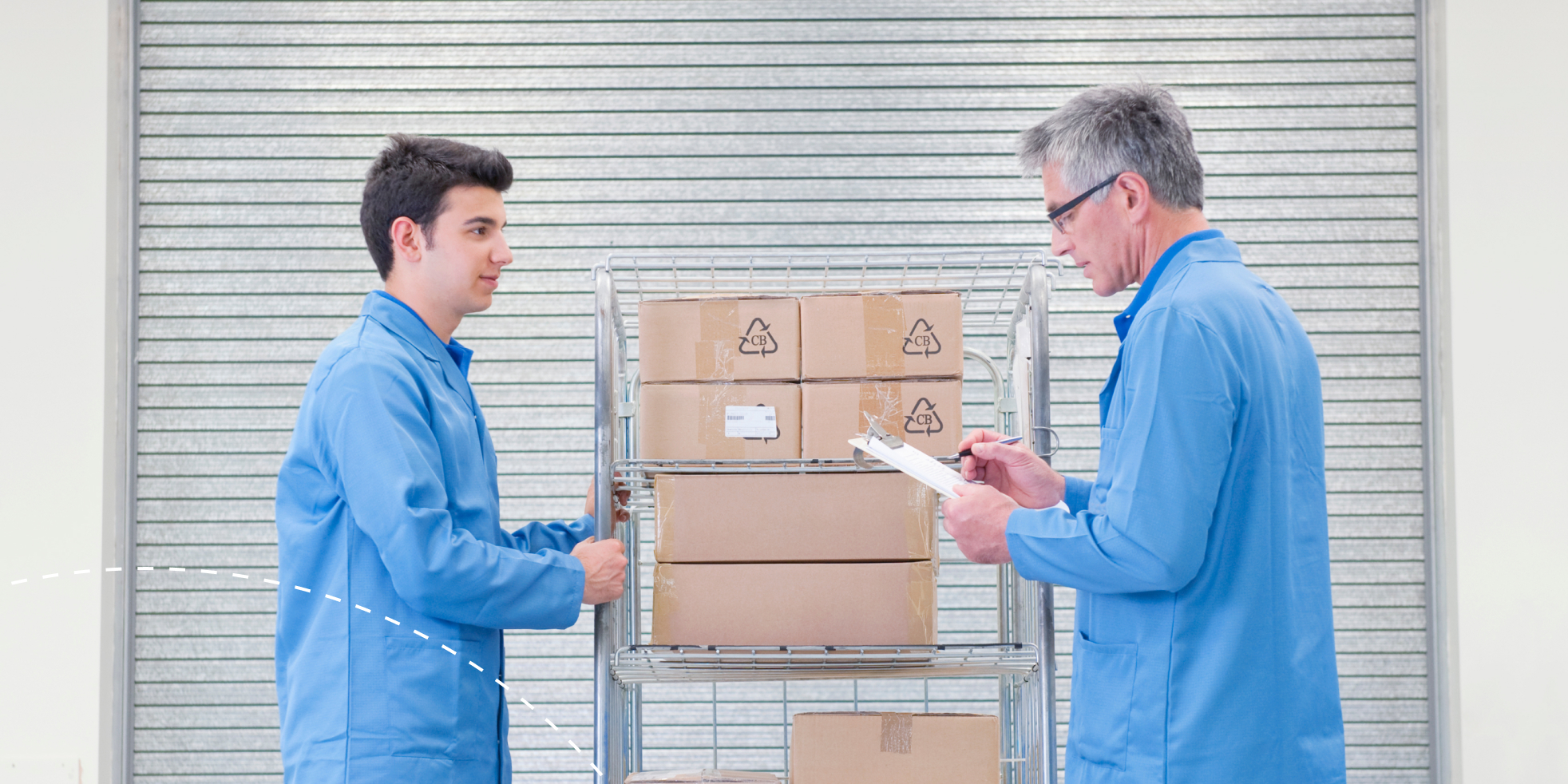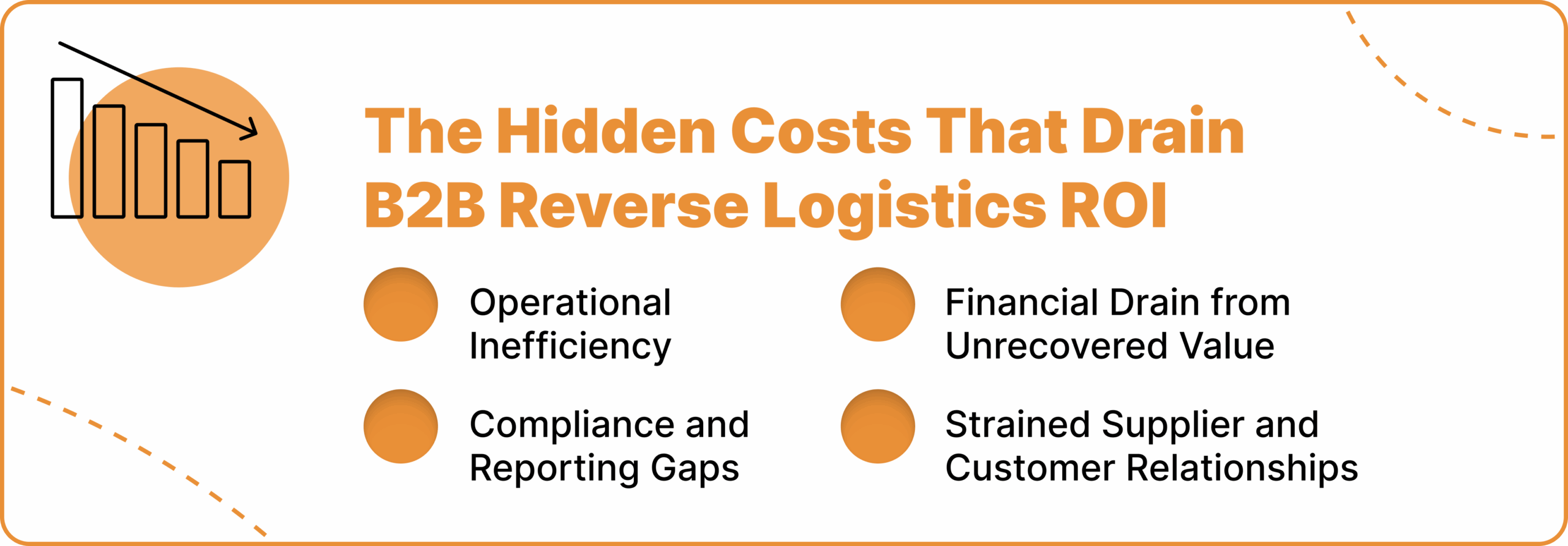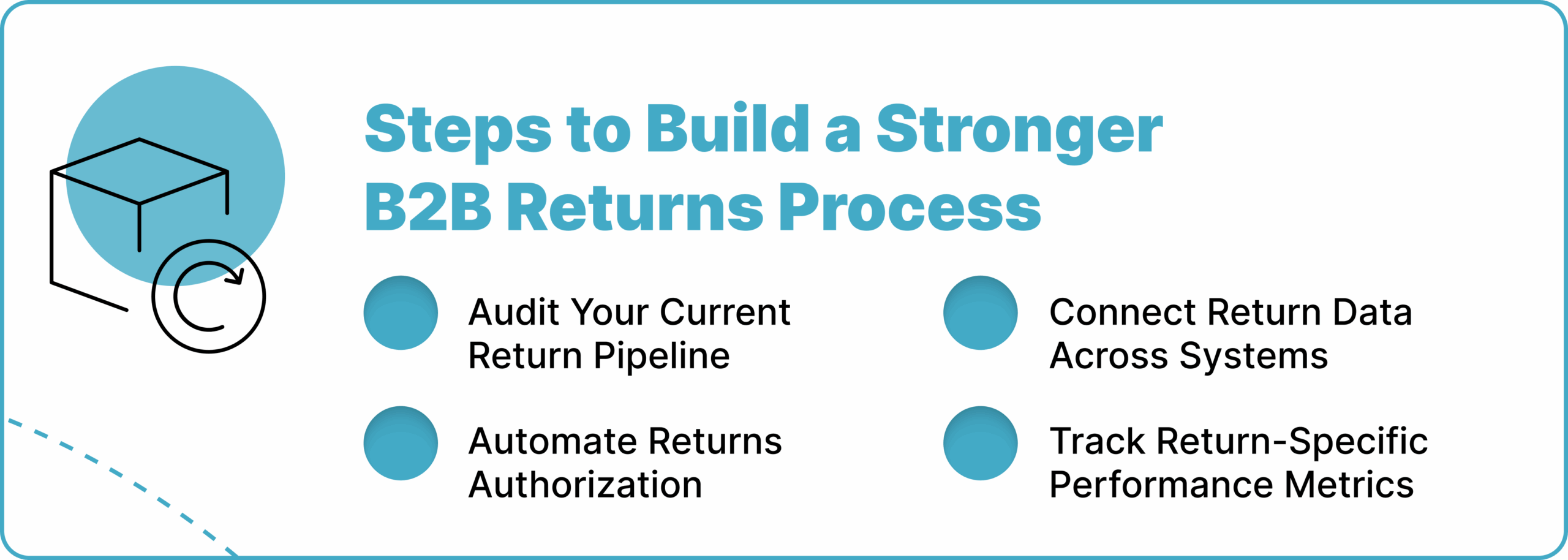The Hidden Cost of Ignoring The B2B Reverse Logistics Process

Key Takeaways
- Ignoring B2B reverse logistics leads to hidden costs, lost revenue, and reduced performance across the supply chain.
- Manual or fragmented returns systems waste labor, inflate warehouse space, and damage supplier trust.
- Proactive returns management with ReverseLogix helps recover value, reduce costs, and improve customer satisfaction.
- A clear, automated reverse logistics process turns returns into measurable ROI and long-term relationship strength.
Unfortunately, even today, B2B reverse logistics is often treated as an afterthought. This is why you see companies allocate resources to outbound shipping, inventory flow, and delivery, but then fall short when investing in the returns process, which plays a key role when those goods come back. That mistake or gap is why the reverse logistics process for B2B transactions is often riddled with delays and losses.
This article shows what can go wrong when businesses overlook their return pipeline and how structured reverse logistics work to restore control, cash flow, and trust. When you ignore B2B reverse logistics, you open the door to lost revenue, strained supplier relationships, and weakened performance across the supply chain.
However, retailers and manufacturers that manage this process with care will not just save money, they will also protect their margins, reduce waste, and improve customer experience.
Why B2B Reverse Logistics Demands Attention
B2B reverse logistics involves the movement of returned goods between businesses, where products are sent back to suppliers, restocked in warehouses, or inspected before crediting. It is not like the B2C, which are often characterized by single-term refunds or post-holiday returns. B2B returns often involve bulk shipments, serialized components, and high-value items moving through inbound logistics channels.
Unlike B2C returns, which are often emotional and preference-based, B2B returns follow contracts, warranties, and operational rules. They often involve third-party logistics providers (3PLs), custom labeling, or even prepaid return labels, all of which make every missed step more expensive for the parties involved in the process.
According to the National Retail Federation, poor reverse logistics costs U.S. businesses a significant sum of total inventory value annually. And that doesn’t even include the long-term harm done to supplier agreements or customer expectations.
The Hidden Costs That Drain B2B Reverse Logistics ROI

You have certain expectations when making your investment into the B2B reverse supply chain, but sometimes that can be derailed by hidden costs such as:
1. Operational Inefficiency
Manual returns processes create friction. Teams have to sort through emails, spreadsheets, and PDFs to authorize return shipments, but it becomes cumbersome when they also have to track all these across disconnected systems. In that case, they will often lose time tracking returns. Each delay adds labor costs, and each mistake inflates warehouse space usage. Without structured return flows, inbound shipments clog docks and choke throughput.
For example, a retailer returning unsold stock from 200 stores without a centralized process will likely see a significant increase in return handling time. That additional time eats into both warehouse bandwidth and outbound logistics schedules. Untracked returns don’t just create backlogs—they disrupt inventory management and cost accounting.
2. Financial Drain from Unrecovered Value
Returned products often still hold value—either as refurbished goods, resale stock, or parts. But if those items sit idle, that value evaporates. Every unprocessed return delays cost recovery, and every missing inspection or lost unit erodes profit margins. The problem compounds when returns aren’t tied to enterprise resource planning systems, which delays credits and causes reconciliation errors.
3. Strained Supplier and Customer Relationships
Returns aren’t just about physical movement—they’re part of how businesses communicate. On one hand, when a supplier receives late or incomplete return data, credits get delayed. And on the other hand, when a customer doesn’t see acknowledgment, trust fades. Poor return handling leads to disputes over condition, credit timing, or contract terms. That friction harms repeat orders and damages brand reputation.
Imagine a business that delays return approvals by two weeks; customers waiting for store credit may withhold future purchases or seek alternate vendors. Small delays compound into long-term losses.
4. Compliance and Reporting Gaps
Commercial returns often trigger reporting obligations—especially in regulated industries. Items returned for environmental disposal, quality control inspection, or product recalls must follow strict handling procedures. A breakdown in the reverse logistics process can violate contractual or legal obligations, putting the business at risk. With more companies aligning with eco-conscious customers and environmental goals, ensuring transparency in returns is no longer optional.
How Proactive B2B Reverse Logistics Drives Business Performance
A proactive reverse supply chain can transform how your business interacts with returns and their impact. Here is how:
1. Recover Value from Every Return
When businesses track condition, warranty status, and supplier rules during returns, they recover more value. This might come from resale, part harvesting, or supplier reimbursement. By automating how items are inspected, routed, and classified during return intake, ReverseLogix ensures your business increases its recovery rates, enabling you to turn dead stock into working capital at a rapid pace.
2. Improve Operational Flow Across Inbound Logistics
Reverse logistics involves more than returns. It reshapes how businesses manage inbound freight, dock scheduling, and warehouse labor. A structured returns process ensures shipments arrive when expected, space is allocated in advance, and processing flows like a well-oiled machine. This way, you can reduce disruptions and improve data quality for the next cycle of outbound logistics.
3. Strengthen Partnerships With Clearer Communication
With a centralized platform, suppliers see return requests as they happen, customers can track approval status and credit timelines, and all parties can work from the same record. This ultimately reduces disputes, aligns expectations, and builds trust over time. ReverseLogix systems allow real-time return updates across third-party partners, keeping customers informed and partners synchronized.
4. Meet Sustainability Goals With Confidence
Modern procurement teams care about waste reduction, and customers expect returns to be processed cleanly and tracked responsibly. Reverse logistics platforms can support recovery, recycling, and reporting—all while reducing the waste of raw materials and excess inventory.
World Economic Forum research shows circular return systems can reduce raw material waste by up to 30%. That’s not just good for public reporting, it’s good for cost control and brand reliability.
Steps to Build a Stronger B2B Returns Process

Improving reverse logistics doesn’t require a full supply chain rebuild. These four steps create fast progress:
- Audit Your Current Return Pipeline: Track return volume, delays, and lost value. Identify inefficiencies that drain resources or confuse teams.
- Automate Returns Authorization: Use technology to standardize approvals, route items correctly, and eliminate email chains.
- Connect Return Data Across Systems: Tie your reverse logistics tools into ERP, warehouse, and carrier systems. That improves visibility and prevents data mismatch.
- Track Return-Specific Performance Metrics: Measure processing time, recovery rates, and return aging. Use this to inform process improvements and reduce costs.
ReverseLogix helps teams take these steps without rewriting their entire supply chain strategy.
Ignoring B2B Returns Is an Expensive Risk
Reverse logistics doesn’t just happen at the loading dock. It affects every corner of your business, from warehouse floors to customer relationships. The cost of ignoring B2B reverse logistics is steep and will often include: lost revenue, missed value recovery, damaged trust, and increased labor costs.
Retailers and manufacturers that manage returns with intention can improve customer experience, protect performance metrics, and reclaim cash that would otherwise disappear. It’s not about fixing returns tomorrow, but how smart you can run today’s returns. ReverseLogix gives you the tools to manage inbound returns, reduce expenses, and get more value from every return shipment—without guesswork.
Frequently Asked Questions
B2B reverse logistics handles high-value, bulk returns between businesses—such as retailers sending goods to manufacturers or suppliers. It involves complex documentation, serialized tracking, and contract-driven processes, unlike consumer returns that are often single-item or preference-based.
Businesses that overlook reverse logistics face hidden operational costs, excess warehouse space use, and delayed credits. All of which can impact customer loyalty. These inefficiencies erode profit margins and can weaken supplier and customer relationships.
Structured reverse logistics systems recover product value through resale, refurbishment, or recycling. Automation also reduces labor costs and processing delays, helping businesses save money while improving customer experience and sustainability metrics.
Returns management platforms like ReverseLogix automate return authorizations, integrate with ERP and warehouse systems, and deliver real-time tracking. This reduces manual errors and creates a transparent, cost-effective process.
Returns affect business operations like inventory management, customer experience, and brand reputation. Efficient B2B reverse logistics transforms returns from a loss center into a competitive advantage, improving overall supply chain performance and trust.
